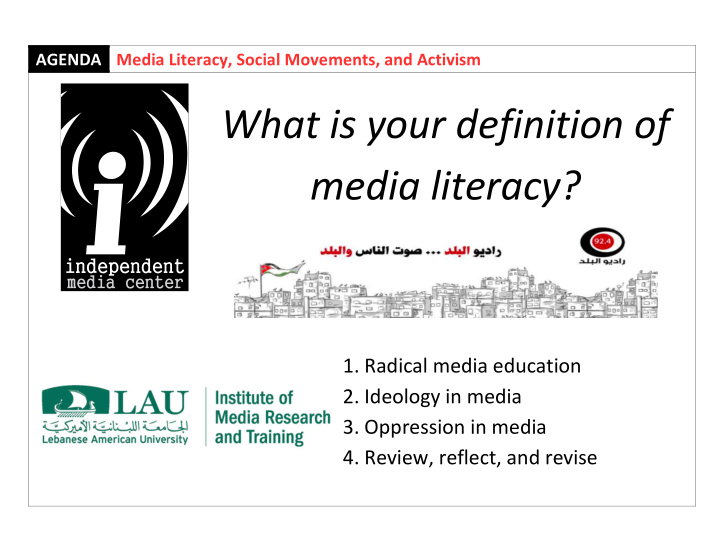



AGENDA Media Literacy, Social Movements, and Activism What is your definition of media literacy? 1. Radical media education 2. Ideology in media 3. Oppression in media 4. Review, reflect, and revise
SCHOLARSHIP Distinguishing Terms Critical Media Literacy “… is a set of competencies that enable us to interpret media texts and institutions, to make media of our own, and to recognize and engage with the social and political influence of media in everyday life” (Hoechsmann & Poyntz, 2012). Media Literacy of the Oppressed “… reframes existing concepts and competencies, engages local communities in the reinvention of media literacy, integrates media literacy critical reading and writing/production as well as participatory activism, prioritizes problems of the oppressed communities….” (Melki, 2017). Forthcoming book Radical Media Education “… moves beyond critique to raise awareness of and chapter practice forms of social movement media, including learning tactics for disrupting hegemonic media practices” (King, forthcoming ).
HALL Ideology in the Media Constructs Race and … Why does Hall (1990) say racism is one of the most profoundly naturalized of existing ideologies? Can you think of any media representations that is overtly or inferentially racist? Race, gender, glass: the politics of news (Stuart Hall, Media Theorized Series ): https://www.youtube.com/watch?v=FWP_N_FoW-I
SHAHEEN How are Arabs Portrayed in Hollywood Films? Planet of the Arabs (Jacqueline Salloum, 2014): https://vimeo.com/100777821
ZAATARI Patriarchal Representations of Gender and Sexuality Patriarchy is represented within Bab el- Hara in various ways. Zeina Zaatari distinguishes between: • Undesirable masculinity • Militarized masculinity • Antimodern masculinity Violence as Romantic in Lebanese Music Videos – The other face of patriarchal violence (Nizar Hassan, 2014): https://www.youtube.com/watch?v=QB-IH_YY1wU
BARNES Disabling Imagery The Undateables – Airing for 10 years on BBC • Pitiable and Pathetic • Object of Violence • Sinister and Evil • Atmosphere or Curio • Super Cripple • Object of Ridicule • Their Own Worst and Only Enemy • Burden • Sexually Abnormal • Incapable of Participating Fully in Community Life • Normal
GINSBURG & BAGGS Politics of Participation https://reelabilities.org/film-directory/ QUESTIONS: 1. How is this an example of first- person presentation ? 2. Is this visual activism ? 3. Does the film offer the audience aesthetic reprogramming experiences? In My Language (Amanda Baggs, 2007) https://www.youtube.com/watch?v=JnylM1hI2jc
MANDOUR Potential Change in Media Discourse on Sexuality in Lebanon July 2012, according to Sahar Mandour (2013), was “a turning point in the discourse on sexuality … moving in the course of one week from shaming homosexuality to shaming institutional homophobia .” • Media discourse on sexuality • Representation of sexuality • Policing of sexuality Videos from HELEM: https://www.youtube.com/watch?v=Grn86Xo2gOY https://www.youtube.com/watch?v=7bPKrXCk4AY
ACTIVITY Oppression in Media: Activism and self-representation Work in groups of 3-4 people and prepare the following to share: • What media oppression (racism, patriarchy, ableism, homophobia) do you want to resist? • Are your proposing a campaign ? Define your message, target audience(s), and online/offline tactics (with at least three activities). • Are you proposing a media production ? Define your medium, what is the message, and include at least three details about the proposed production. Radio Free Palestine: http://RadioFreePalestine.org/
LAST WORD Review, Reflect, and Revise FIRST – Review, reflect, and revise your definition of media literacy. SECOND – Prepare to share your revision.
REFERENCES Thank you! Barnes, C. (1992). Disabling Imagery and the Media. The British Council of Organisations of Disabled People [Report]. Retrieved from: http://www.media-diversity.org/en/index.php?option=com_content&view=article&id=601 Ginsburg, F. (2016). Cripping the Infrastructure: Disability, Media and "The New Normal." Working Papers in Anthropology 2(3). Leuven: KU Leuven. Retrieved from: https://soc.kuleuven.be/immrc/files/wpa-2016-2-1-faye-ginsburg.pdf Hall, S. (1990). The Whites of Their Eyes: racist ideologies and the media. In Alvarado, M., and Thompson, J., (Eds.) The Media Reader (pp. 89-93). Retrieved from: http://www.appstate.edu/~hallcl/READING%20ASSIGNMENTS/3534%20wk8-stuarthall.PDF Mandour, S. (2013). Potential Change in Media Discourse on Sexuality in Lebanon: "Cinema Plaza" and Beyond [Reuters Institute Fellow's Paper]. Retrieved from: https://reutersinstitute.politics.ox.ac.uk/our-research/potential-change-media-discourse- sexuality-lebanon-cinema-plaza-and-beyond Melki, J. (2017). Guest editorial: Towards a media literacy of the oppressed. Media Education Research Journal , 8(1), 5-14. Retrieved from: http://merj.info/wpcontent/uploads/2018/02/MERJ_8.1_Editorial.pdf Shaheen, J. G. (2003). Reel Bad Arabs: How Hollywood Vilifies a People. The ANNALS of the American Academy of Political and Social Science , 588(1), 171–193. Retrieved from: https://islamophobiaisracism.files.wordpress.com/2017/03/shaheen-reel-bad- arabs-short.pdf Hoechsmann, M., and Poyntz, S.R. (2012). Media literacies: a critical introduction . UK. Wiley-Blackwell Publishing Ltd. Retrieved from: https://www.wiley.com/en-lb/Media+Literacies:+A+Critical+Introduction-p-9781405186117 Zaatari, Z. (2015). Desirable Masculinity/Femininity and Nostalgia of the ‘‘Anti-Modern’’: Bab el-Hara Television Series as a Site of Production. Sexuality & Culture 19: 16–36. Retrieved from: https://link.springer.com/article/10.1007%2Fs12119-014-9242-5
Recommend
More recommend